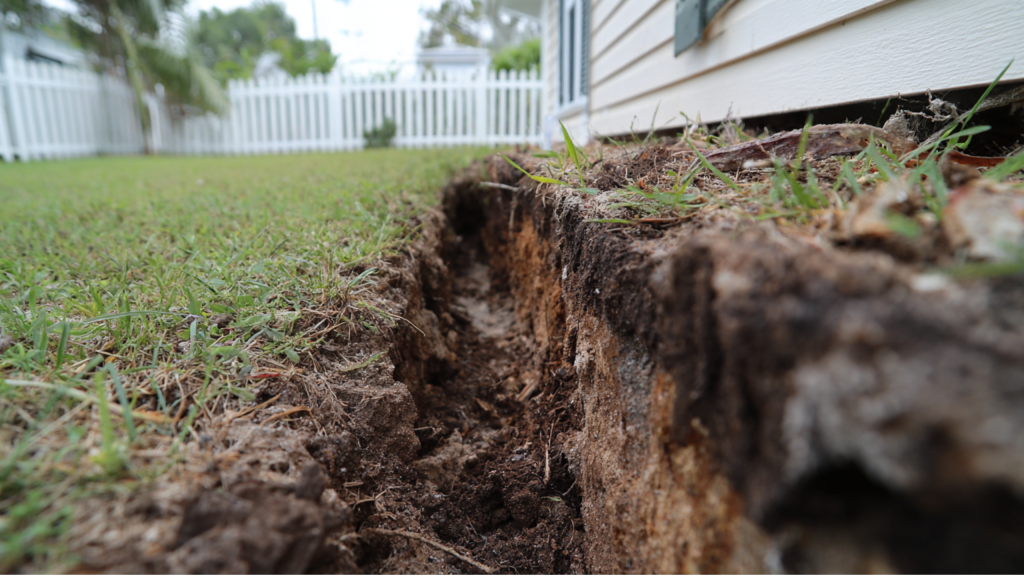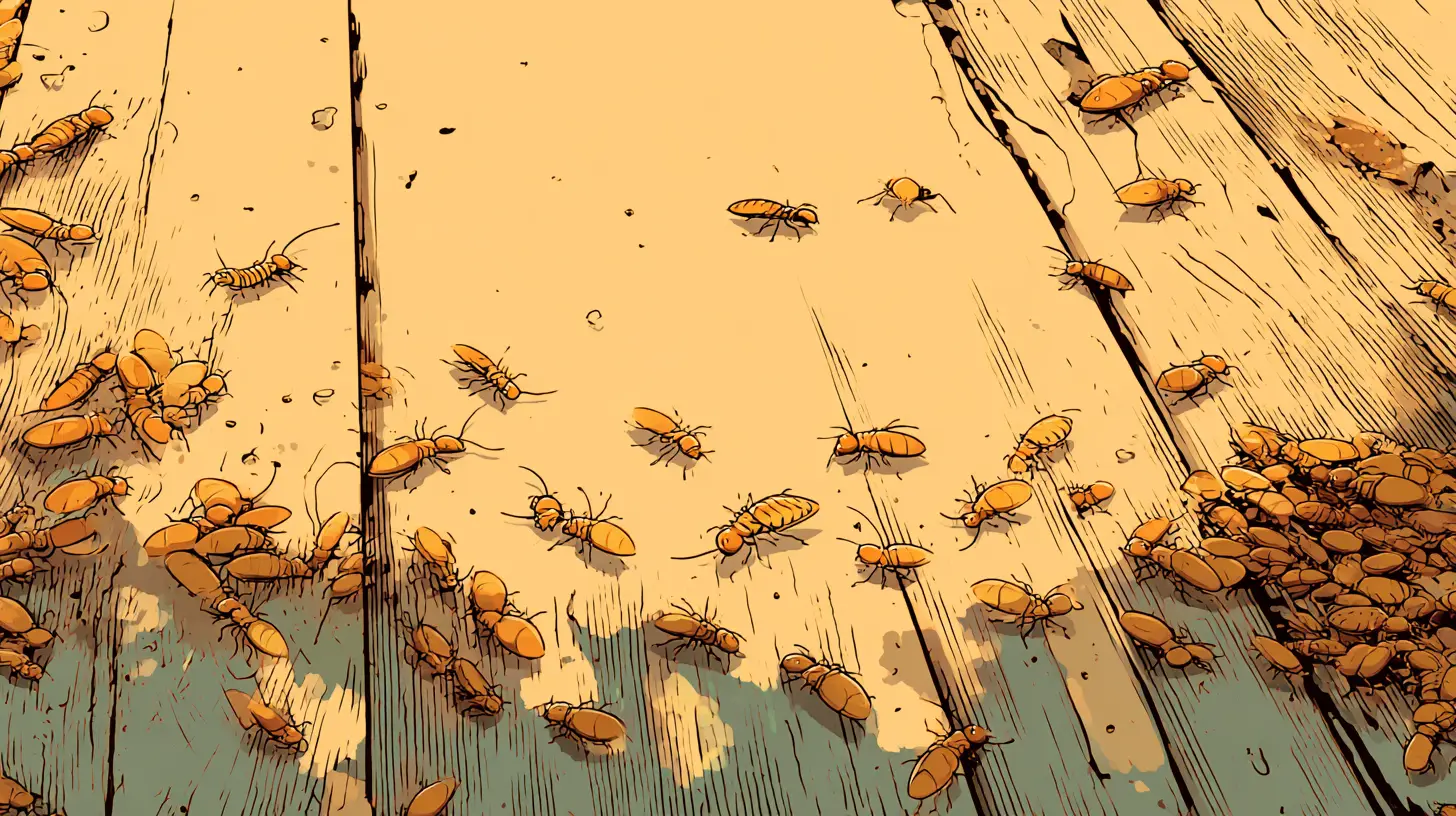
Table of Contents
Termite trenching in Bradenton, FL isn’t a Pinterest project. It’s dirt under your nails, Gulf humidity in your face, and the very glamorous act of building a chemical moat so a million tiny wood-eaters stop treating your house like an all-night diner. Termites rack up $5+ billion in damage each year in the U.S., and Florida sits right in the splash zone. Bradenton’s sandy soils? VIP access for subterranean termites.
Key Takeaway
- Bradenton is termite country – the warm climate and sandy soils mean subterranean termites are a near-certainty.
- Dig a 6″ wide x 6″ deep trench directly against your foundation to intercept termites where they travel.
- Apply 4 gallons of finished solution per 10 linear feet of trench (at ~0.06% fipronil for standard use, up to 0.125% for stubborn clay soil).
- Non-repellent termiticides (like fipronil or imidacloprid) work best because termites don’t detect them and spread the poison throughout the colony.
- Repellent products (like bifenthrin) just force termites to detour, leaving gaps that can still lead them inside.
- Work in 8–10 foot sections to avoid overexertion and keep your mix consistent.
- Backfill in layers and treat the soil as you go to create a continuous, treated “layer cake” barrier.
- Avoid trenching right before heavy rain—Florida downpours can wash away fresh treatments.
- Check mud tubes 2–4 weeks later—if they’re not rebuilt, the treatment is working.
- Properly applied fipronil barriers can last up to 10 years, but inspect annually since storms or digging can break the protection.
Why Bradenton? Because Sand + Warmth = Termite Disneyland
- Subterranean termites tunnel in soil, then elevator up through mud tubes. Colonies can hit the millions.
- Formosan subterranean termites (the overachievers) build monster colonies and long tubes. They’re here, they’re busy, and they don’t care about your mortgage.
- They’re not fast like a chainsaw, but they’re relentless. Think 24/7 jaws wearing down beams, baseboards, and your patience.

Get Termite-Free Today!
Trust Waves Pest Control for expert termite control in Bradenton, FL. Call now or request your free termite inspection online!
Request an InspectionChemistry: Pick the Poison That Doesn’t Smell Like Poison
- Use a non-repellent. Termites shouldn’t detect it. They need to walk through it, groom each other with it, and carry it home.
- Fipronil (liquid concentrate) is the go-to for trenching. It’s slow-acting on purpose—gives plenty of time for transfer through the colony.
- Imidacloprid (often in granules) is also non-repellent, fine for sandy soils, but trenching with liquid beats a quick sprinkle when you want full coverage.
- Repellents (old-school pyrethroids like bifenthrin) just say “detour.” Termites take the scenic route and find a gap.
The Quick Mix & Rate Cheat Sheet
- Target dilution (fipronil):
- 0.06% = 0.8 fl oz concentrate per gallon water
- 0.125% = 1.6 fl oz per gallon (higher label rate; handy for stubborn clay)
- Application volume: 4 gallons of finished solution per 10 linear feet of trench (at ~6″ depth).
- Section size: Work in 8–10 ft chunks so you don’t create a trench the size of the Skyway.
Step-By-Step: Make a Moat (That They Can’t See)
- Prep the line. Pull back mulch/rock. Expose soil right against the foundation. Mark 10-ft sections.
- Dig the trench. 6 inches wide x 6 inches deep, hugging the foundation. Pile the soil beside you for backfill.
- Mix your batch. 5-gal bucket, PPE on, measure accurately (this isn’t margaritas). For each 10-ft section you’ll need 4 gallons of finished mix.
- Flood the trench. Pour slow and even so the soil drinks it. Sandy Bradenton soil says “yum.” Clay gives you side-eye—go slower there.
- Backfill in layers. Toss 2–3″ of soil back in, wet that layer, finish filling, wet the top. You’re building a treated “layer cake” termites have to cross.
Pro move: Label a bucket “4 gallons” with a Sharpie after measuring with a 1-gal jug. You’ll hit the ratio every time without math brain cramps.
Florida Realities: Weather, Slabs, and Crawlspaces
Rain Games (Gulf-Coast Edition)
- Skip trenching if a downpour in the next 24–48 hours looks likely. Fresh treatment + flash rain = money flowing down the driveway.
- Don’t treat flooded/soupy soil. Wait until it’s just moist, not a mud smoothie.
Slabs, Patios, Driveways
- Where concrete kisses your foundation, soil access is blocked. Standard play: drill holes through the slab (about 3–6″ from the wall, typically ~12″ apart, ½” bit), then inject until you deliver the label volume under there.
- Don’t want to touch your patio? Trench around the outer edges of that slab and watch the adjacent interior (garage base of walls). If activity pops up later, you can drill just that area.
Crawlspaces & Piers
- See active mud tubes inside the crawl? Trench the interior foundation line too.
- No tubes? Focus outside. Crawlspace trenching is misery cardio—save it for proven activity.
- Homes on piers/posts: trench around each pier that hits the soil.
Soil Talk: Sand vs. Clay (Bradenton Has Both in Pockets)
- Sandy zones: absorbs like a champ. Your biggest risk is runoff if you pour too fast on a slope.
- Clay/hardpan pockets: liquid can stall. Options:
- Use the higher label rate (0.125%) to apply less water while delivering the same active.
- Pour slower, work shorter sections, and rough up the trench bottom for better penetration.
- Wider trench = more soil face to soak into.
Extra Firepower: When You Want the Colony Done-Done
- Foam in tubes/wood: After 2 weeks, scrape a 2″ window in each mud tube and inject fipronil foam in both directions. Have a known hot spot in a stud/baseboard? Drill tiny holes ~4″ apart and foam the void. Foam expands, reaches galleries, and termites eat the problem.
- Leave chewed wood in place until activity stops. It’s their favorite restaurant—turn it into a trap first. Replace once quiet.
Safety That Doesn’t Require a Lecture
- Gloves, goggles, long sleeves. Keep kids/pets away until the trench is filled and dry.
- Mix outside, avoid splashes, wash up if you get any on skin.
- Don’t let mix run into storm drains, ponds, or wells. Keep the chemistry in the trench where it belongs.
Aftercare: How You Know It Worked
- Week 2: Pop a 2″ gap in every old mud tube. No rebuild = you’re winning.
- Week 4–8: Re-check. Activity should be gone or fading. Still seeing fresh tubes after ~8 weeks? Re-treat missed gaps or foam targeted spots.
- Annual ritual: Quick perimeter walk, look for tubes, wood-soil contact, or soggy areas that might have eroded your treated band.
Numbers to Keep Handy
- Trench size: 6″ x 6″
- Mix rate (fipronil): 0.8 oz/gal (standard), 1.6 oz/gal (higher label rate)
- Volume: 4 gal per 10 linear feet
- Slab drilling (if you do it): roughly 12″ spacing, ½” bit, inject to label volume
- Typical protection window (well-applied fipronil barrier): years, often long-term; big storms or digging can break it—patch those spots
Frequently Asked Questions (FAQs)
Does trenching nuke the entire colony?
Often, yes—transfer inside the colony can do the job over ~2–3 months. Either way, the barrier blocks your structure fast, which is the goal.
Granules or liquid?
Granules with imidacloprid can help in sandy zones, but for reliable, continuous coverage, liquid trenching wins. If granules didn’t stop activity, trench.
What about patios pressed to the house?
If you’ll drill: go ~12″ spacing and inject under the slab. If you won’t: trench the slab’s outer edges and monitor the nearest interior. Spot-treat later if needed.
How long until I see a change?
You should see no rebuild on scraped tubes in 2–4 weeks. Full quiet often lands by 6–8 weeks with non-repellents.
Is this safe around kids and pets?
The concentrate is hazardous—treat it like bleach on steroids. Once applied, backfilled, and dry, exposure risk drops way down. Block off the work zone until you’re done.
Do I need to trench the inside too?
Only if you see active tubes inside a crawlspace or a specific interior slab edge shows activity. Most Bradenton homes do fine with a thorough exterior trench.










